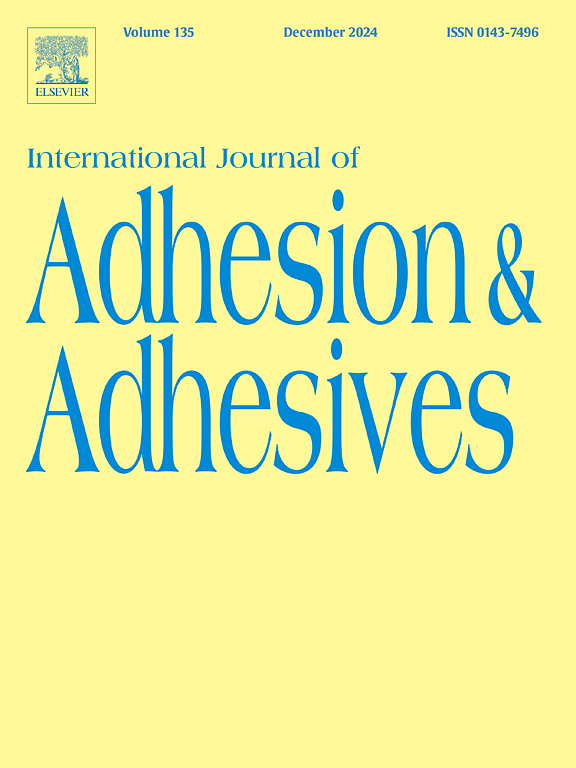Optimization design and curing behaviors of polyurethane (PU) modified asphalt from the perspective of cohesion-adhesion variations
IF 3.5
3区 材料科学
Q2 ENGINEERING, CHEMICAL
International Journal of Adhesion and Adhesives
Pub Date : 2025-04-12
DOI:10.1016/j.ijadhadh.2025.104034
引用次数: 0
Abstract
Interface properties of asphalt and aggregate intimately affect the service-performance and durability of asphalt pavement. The research aimed to explore the cohesion-adhesion characteristics of polyurethane (PU) modified asphalt, and thus optimizing its constituent proportion and understanding its curing behaviors. To this end, several proportion schemes of PU modified asphalt were first designed with response surface methodology (RSM), and the corresponding asphalt binders were prepared and their cohesion-adhesion features were characterized based on contact angle test and thermodynamic theory. On this basis, the effects of composition ratio and its interactions on the cohesion-adhesion features were analyzed and the optimal composition ratio was determined. Lastly, the adhesion features of PU modified asphalt during its curing period were measured using pull-out test and atomic force microscopy (AFM), and thus the curing behaviors were expounded. The results showed that the composition-associated factors had interactive impacts on the cohesion and adhesion of PU modified asphalt, wherein the influence of PU prepolymer on the adhesion was more significant as the curing agent was incorporated at the high ratio. Further, the increase of compatibilizer and diluent adversely affected the cohesion-adhesion capacity of PU modified asphalt, and for obtaining the favorable cohesion-adhesion competence, the optimal constituent proportion was determined as PU prepolymer: curing agent: compatibilizer: diluent = 14: 1.80: 1.88: 3.12. During the curing process, the adhesion performance and microscopic phase structure of PU modified asphalt exhibited the character of an initially visible ascending variation followed by a tendency to stabilize, and the eventual adhesion properties were not related to the solidification temperature set in the research. The research is of great significance for guiding the development of PU modified asphalt with satisfactory interfacial properties and understanding its curing process.

从粘聚力变化的角度看聚氨酯(PU)改性沥青的优化设计和固化行为
沥青与集料的界面性能直接影响沥青路面的使用性能和耐久性。本研究旨在探索聚氨酯(PU)改性沥青的粘结特性,从而优化其组成比例,了解其固化行为。为此,首先采用响应面法(RSM)设计了几种聚氨酯改性沥青的配比方案,制备了相应的沥青粘结剂,并基于接触角试验和热力学理论对其粘结性能进行了表征。在此基础上,分析了组成比及其相互作用对黏附性能的影响,确定了最佳组成比。最后,采用拉拔试验和原子力显微镜(AFM)测试了PU改性沥青在养护期间的粘附特性,从而阐述了PU改性沥青的养护行为。结果表明:组成相关因素对PU改性沥青的黏聚性和附着力有相互作用的影响,其中PU预聚体对附着力的影响随着固化剂掺入比例的增加而更加显著。同时,增容剂和稀释剂的添加对PU改性沥青的粘接性能有不利影响,为获得较好的粘接性能,确定了PU预聚体:固化剂:增容剂:稀释剂= 14:1.80:1.88:3.12。在固化过程中,PU改性沥青的粘附性能和微观相结构表现出先明显上升变化后趋于稳定的特征,最终的粘附性能与研究设定的固化温度无关。该研究对于指导开发界面性能满意的PU改性沥青,了解其养护过程具有重要意义。
本文章由计算机程序翻译,如有差异,请以英文原文为准。
求助全文
约1分钟内获得全文
求助全文
来源期刊

International Journal of Adhesion and Adhesives
工程技术-材料科学:综合
CiteScore
6.90
自引率
8.80%
发文量
200
审稿时长
8.3 months
期刊介绍:
The International Journal of Adhesion and Adhesives draws together the many aspects of the science and technology of adhesive materials, from fundamental research and development work to industrial applications. Subject areas covered include: interfacial interactions, surface chemistry, methods of testing, accumulation of test data on physical and mechanical properties, environmental effects, new adhesive materials, sealants, design of bonded joints, and manufacturing technology.
 求助内容:
求助内容: 应助结果提醒方式:
应助结果提醒方式:


